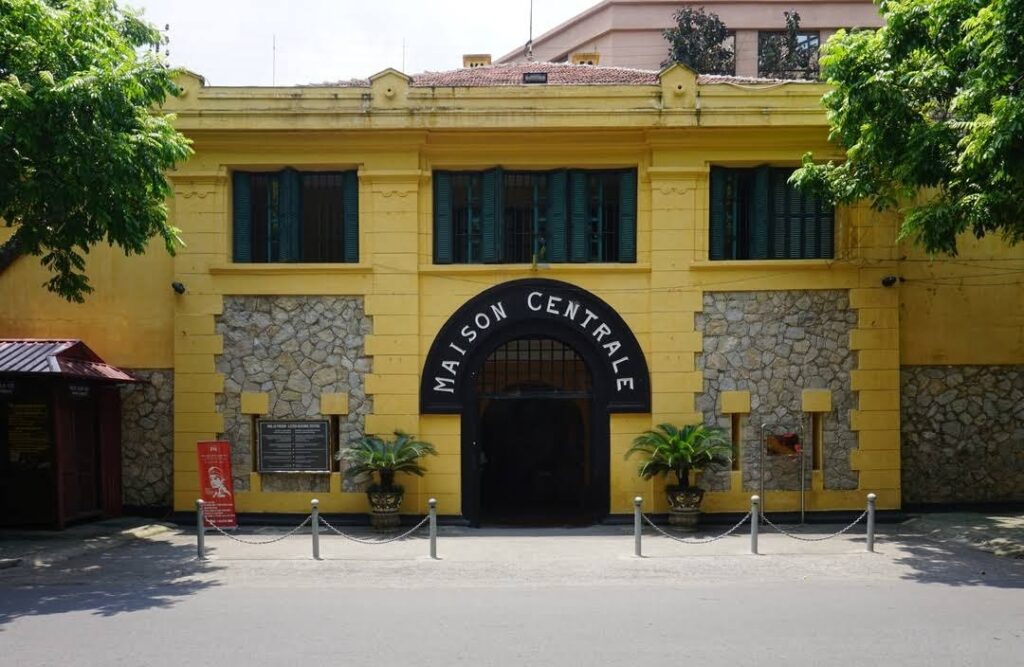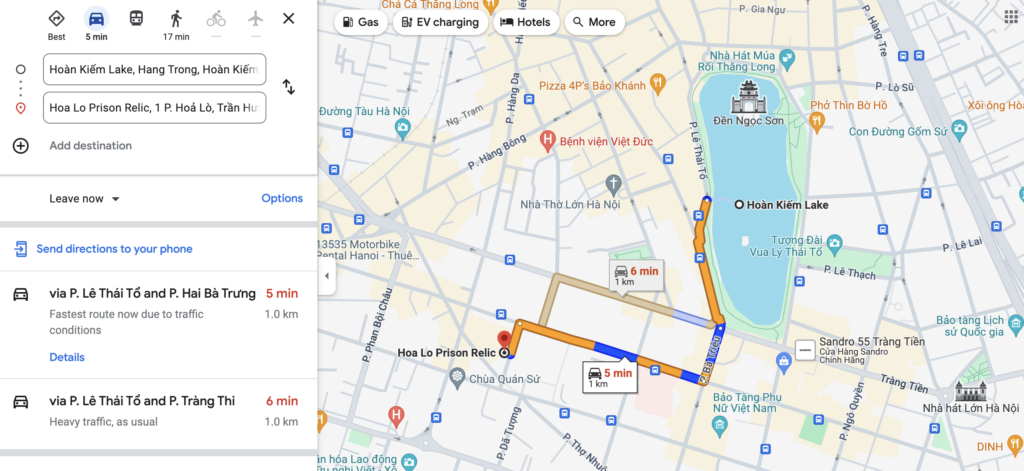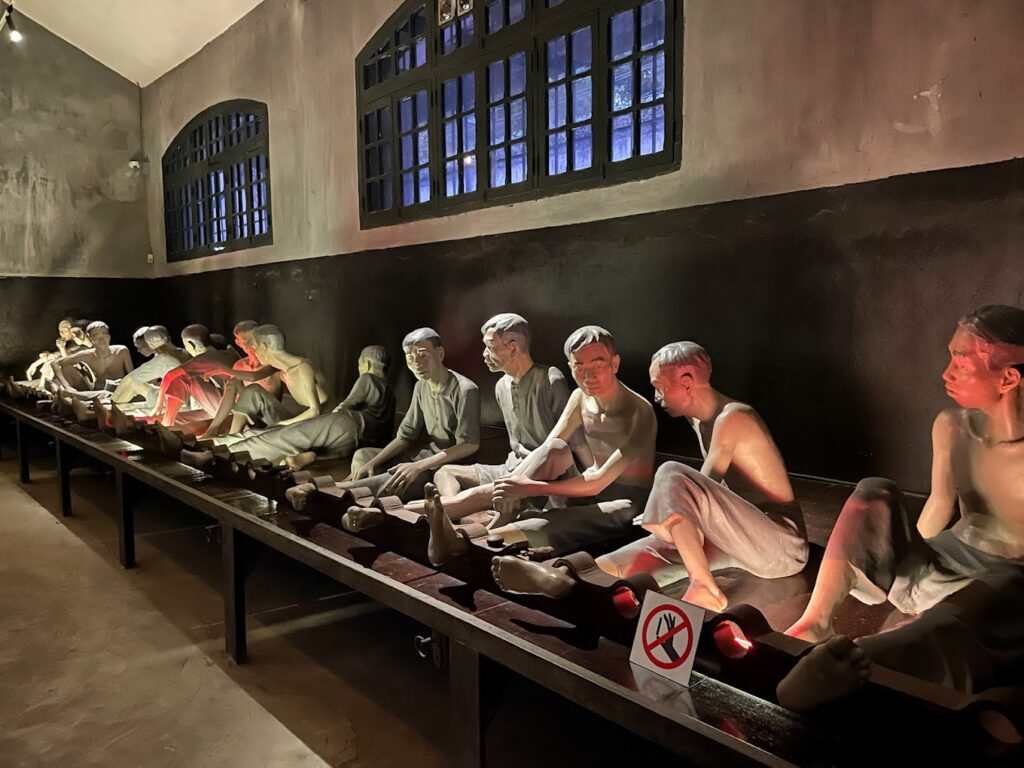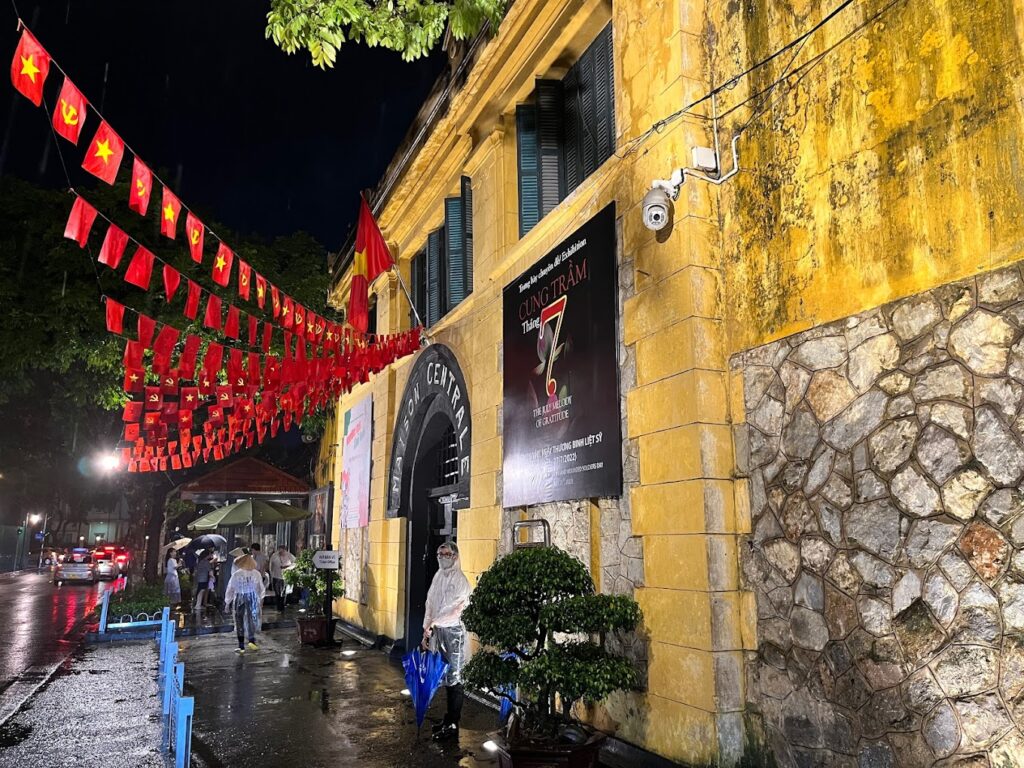
Exploring Hoa Lo prison in Hanoi
When mentioning Hoa Lo Prison - one of the fascinating tourist destinations in Hanoi, people often immediately think of the painful images of prisoners detained here, closely associated with the ruthless and inhumane actions of the French colonialists. This has become an unforgettable haunting memory in the minds of the Vietnamese people. Let’s explore this historical site with Jackfruit Adventure!

Where is Hoa Lo Prison in Hanoi, Vietnam?
- Address: No. 1, Hoa Lo Street, Hoan Kiem District, Hanoi.
Hoa Lo Prison is located at 1 Hoa Lo Street, in the central area of Hoan Kiem District, Hanoi, near many famous tourist attractions. Visitors can reach this site through various means of transportation, including both personal and public options.

Situated in the central area, it is easy to find Hoa Lo Prison using personal or public transportation (Photo: collected)
If starting from Hoan Kiem Lake, head along Le Thai To Street toward Hang Trong and proceed straight across Bà Triệu Street. Then, turn right onto Hai Ba Trung Street, continue for approximately 500m, and turn left onto Hoa Lo Street. Hoa Lo Prison is located at number 1 on this street.
For those looking to save on transportation costs, buses are a convenient option. Buses such as numbers 32, 02, 38, and 41 have stops near Hoa Lo Prison for easy access.
How to visit Hoa Lo prison from Hanoi Old Quarter?

To visit Hoa Lo Prison from Hanoi Old Quarter, you have several transportation options:
- Walking from Hanoi Old Quarter to Hoa Lo Prison is feasible, especially if you enjoy exploring the city on foot. The prison is located in the Hoan Kiem District, and it’s approximately a 15 to 20-minute walk from the Old Quarter. Simply head southwest from Hoan Kiem Lake or any point in the Old Quarter along Le Thai To Street, then turn right onto Hai Ba Trung Street, where you’ll find Hoa Lo Prison.
- Taking a taxi or Grab is a convenient option if you prefer a quicker and more comfortable journey. You can easily book a taxi or Grab from any location in the Old Quarter and specify Hoa Lo Prison as your destination. This option is suitable for those who want to save time and effort.
- Renting a bicycle or motorbike provides flexibility and allows you to explore the city at your own pace. You can navigate the streets of Hanoi from the Old Quarter to Hoa Lo Prison, enjoying the sights along the way. However, be mindful of traffic conditions and safety precautions while riding.
These transportation options offer flexibility and convenience for travelers looking to visit Hoa Lo Prison from Hanoi Old Quarter. Choose the option that best suits your preferences and travel style.
Historical Site - Hoa Lo Prison Opening Hours and Ticket Prices

Hoa Lo Prison is open from 8:00 am to 5:00 pm every day, including holidays.
The entrance fee for Hoa Lo Prison is 30,000 VND per person. Certain individuals are eligible for free admission or discounted tickets, including:
Free admission for:
- Children under 15 years old.
- Individuals with severe disabilities.
- Free or 50% discount for: Members of veteran associations, the National Prison Contact Board, and the anti-French resistance liaison committee.
- Individuals with contributions to the revolution.
50% discount for:
- Students (with valid student ID).
- Severely disabled individuals.
- Vietnamese citizens aged 60 or above.
- Individuals classified under social policy.
Additionally, audio guide services are available at Hoa Lo Prison for 50,000 VND per headphone.
Things to Know About Hoa Lo Prison
1. History of Hoa Lo Prison

To cope with the resistance movements of the Vietnamese people in the late 19th century, the French colonialists strengthened their oppressive machinery by adding police forces, improving the court system, and constructing a network of prisons. In 1896, on the land of Phu Khanh village in Vinh Xuong district, Tho Xuong commune, Hanoi, the French colonialists built Hoa Lo Prison - one of the largest prisons of the French colonialists in Indochina.
The land of Hoa Lo was previously a famous handicraft pottery village. However, the French colonialists transformed it into a place of confinement, imprisonment, depriving the freedom of both the physical and spiritual aspects of thousands of patriotic soldiers and revolutionary activists in Vietnam. Despite living in a harsh imprisonment environment, the soldiers remained steadfast and maintained revolutionary spirit. They transformed Hoa Lo Prison into a school where revolutionary theories were disseminated, and many ingeniously planned escapes to return to the people and organizations, continuing to contribute to the national liberation cause.
Numerous prominent leaders were detained by the French colonialists at Hoa Lo Prison, including figures like Phan Boi Chau, Nguyen Quyen, Nguyen Luong Bang, Luong Van Can, Ho Tung Mau, and five General Secretaries of the Communist Party of Vietnam: Nguyen Van Cu, Le Duan, Truong Chinh, Do Muoi, and Nguyen Van Linh. After North Vietnam achieved independence, the Vietnamese Government took over and temporarily used Hoa Lo Prison to detain individuals who violated the law. However, from August 5, 1964, to March 31, 1973, Hoa Lo Prison was also used to detain American pilots shot down while carrying out bombing missions in North Vietnam.
In 1993, the Vietnamese Government decided to repurpose Hoa Lo Prison to meet the economic development needs of the capital. A portion of the southeast part of the prison was preserved, renovated, and embellished to be classified as a Historical Site of Hanoi. This Hanoi tourist destination now features a memorial commemorating the patriotic soldiers and revolutionaries who bravely sacrificed at the prison for the independence and freedom of the nation.
2. Giant Guillotine - the Dread of Every Prisoner
Inside Hoa Lo Prison, there is a guillotine. This is a killing tool created by the French doctor Guillotane, considered a humane means of execution to replace medieval forms of execution such as hanging and beheading.

The guillotine consists of main parts such as:
- The chopping table, a flat surface made of wood, where the prisoner lies during the execution, with the head placed in the circular hole in the machine’s body.
- The chopping frame, an iron frame nearly 4 meters high, with a groove for the blade to move and operate.
- The blade, made of steel with a diagonally sharpened edge.
During the execution, the blade cover presses a latch, and a pull cord releases the blade from above with a force equivalent to 60kg. Subsequently, the prisoner’s head falls into the tin bucket below, while the body is placed in a wicker basket.
3. “Solidarity” Banyan Tree - Historical Evidence
According to the accounts of some former political prisoners at Hoa Lo Prison, the origin of the banyan tree dates back to before 1930, when prisoners were sentenced to labor for sanitation near the courthouse. They collected wild banyan trees from the grassy clusters and planted them in the prison courtyard. Over time, the banyan trees grew and became associated with many generations of political prisoners at the prison.
Whenever allowed outside, political prisoners would gather around the banyan tree to enjoy the fresh air and discuss measures against the colonial regime. The Banyan tree became a witness to the daily lives, shared thoughts, dreams, goals, ideals, and emotions of communist individuals. Additionally, it served as an important “secret mailbox” for prisoners to exchange information and propagate revolutionary documents.
4. Solitary Confinement (Dark Cell) - Hell within Hell
The solitary confinement area consists of dark cells with an area of only 4m2, with walls painted in a dark and gloomy black color. This place lacks light and ventilation, creating a sensation for prisoners as if they were in an extremely stifling tomb.
The prisoner’s sleeping place is made of specially hardened cement, causing the head to incline downward, resulting in blood pooling in the brain. Solitary confinement is used to punish those who organized resistance, propagated revolutionary ideas, or attempted escapes. Comrade Truong Chinh was also once imprisoned here when he organized a demonstration inside the prison to commemorate International Labor Day.
Touring Hoa Lo Prison
When you visit Hoa Lo Prison, you can choose between daytime and nighttime tours, depending on your time and interests. Each tour offers different experiences, so if you can, it’s a good idea to do both to see everything.
1. Day Tour of Hoa Lo Prison
During the day, tickets for the tour cost only 30,000 VND per person. Once you have your ticket, you can rent a headset to listen to stories and quotes from people who were once in the prison. There are also signs with information in each room.
As you start the tour, you’ll explore different parts of the prison, from well-lit areas to completely dark spaces. The displayed items and stories will surely make you feel the harshness of the French colonial rule.
2. Night Tour of Hoa Lo Prison
Hoa Lo Prison organizes a night tour called the “Sacred Night” to help people understand more about the pain of the wars in Vietnam. The tour uses sound, light, and performances by actors to give visitors a vivid experience of the intense struggles of soldiers who sacrificed for peace and democracy.
Apart from the captivating sights and sounds, the staff at Hoa Lo Prison also gives out souvenir gifts like tea, sweets, and jelly made from the last remaining banyan tree in the prison.
The ticket for the night tour costs 300,000 VND per person. The organizers will also take pictures for the group, so you can look back at them later.
Visiting Hoa Lo Prison Experience
To have a smooth trip, remember the following notes and useful experiences:
- Only bring necessary and lightweight items. Do not bring explosive materials into the prison. Before entering, store bulky luggage in the designated area.
- While touring, avoid smoking, behave courteously, speak moderately, and do not move arranged exhibits.
- If you want to light incense and lay flowers, only do so in the memorial area.
- On weekends, it’s usually crowded, but you don’t have to worry about booking tickets in advance as you can easily purchase them at the entrance. If you want to hire a guide, make an appointment beforehand.
- If you’re visiting with a large group or for research purposes, contact the management in advance for assistance with preparation.
Conclusion
Hoa Lo Prison is a place that bears witness to the sacrifices, hardships, and fierce spirit of struggle of the patriotic revolutionary soldiers. It serves as a compelling indictment of the cruel prison system imposed by French colonialists. Additionally, it stands as evidence of the humane policies of the Vietnamese Government towards American pilots during their captivity. The prison is not only a captivating tourist attraction but also a site for imparting patriotic traditions to the Vietnamese people, especially the younger generation. Visit Hoa Lo Prison once to experience and learn about the history, and traditions of Viet Nam! Time to explore Hanoi and Ho Chi Minh city Cycling tour.
Link nội dung: https://truyenhay.edu.vn/hoa-loa-a68442.html